The 4 Types of Rosacea and How to Treat Flare-Ups with Natural Options
Your Guide to the 4 Types of Rosacea: Holistic Approaches to Controlling Symptoms
Imagine this… among the bustling crowds around the world, an astounding 415 million people are quietly navigating the challenges of rosacea; that is 5.46% of the entire world’s population.1 2
You are not alone! Rosacea’s reach is global, affecting so many.
Our goal today is to offer you some insight into the four types of rosacea and explore some practical solutions.
Whether you seek comfort, clarity, or natural ways to manage rosacea, you’re in the right place.
Let’s embark on this journey of discovery and healing together.
Key Takeaways:
- Patients with rosacea can develop symptoms of multiple subtypes of rosacea simultaneously.
- Proper diagnosis by a physician is necessary, yet traditional treatments can be costly and lifelong.
- Consider a functional medicine or naturopathic doctor to naturally treat the underlying causes of rosacea.
- There are four main types of rosacea: Erythematotelangiectatic, Papulopustular, Phymatous, and Ocular.
What is Rosacea?
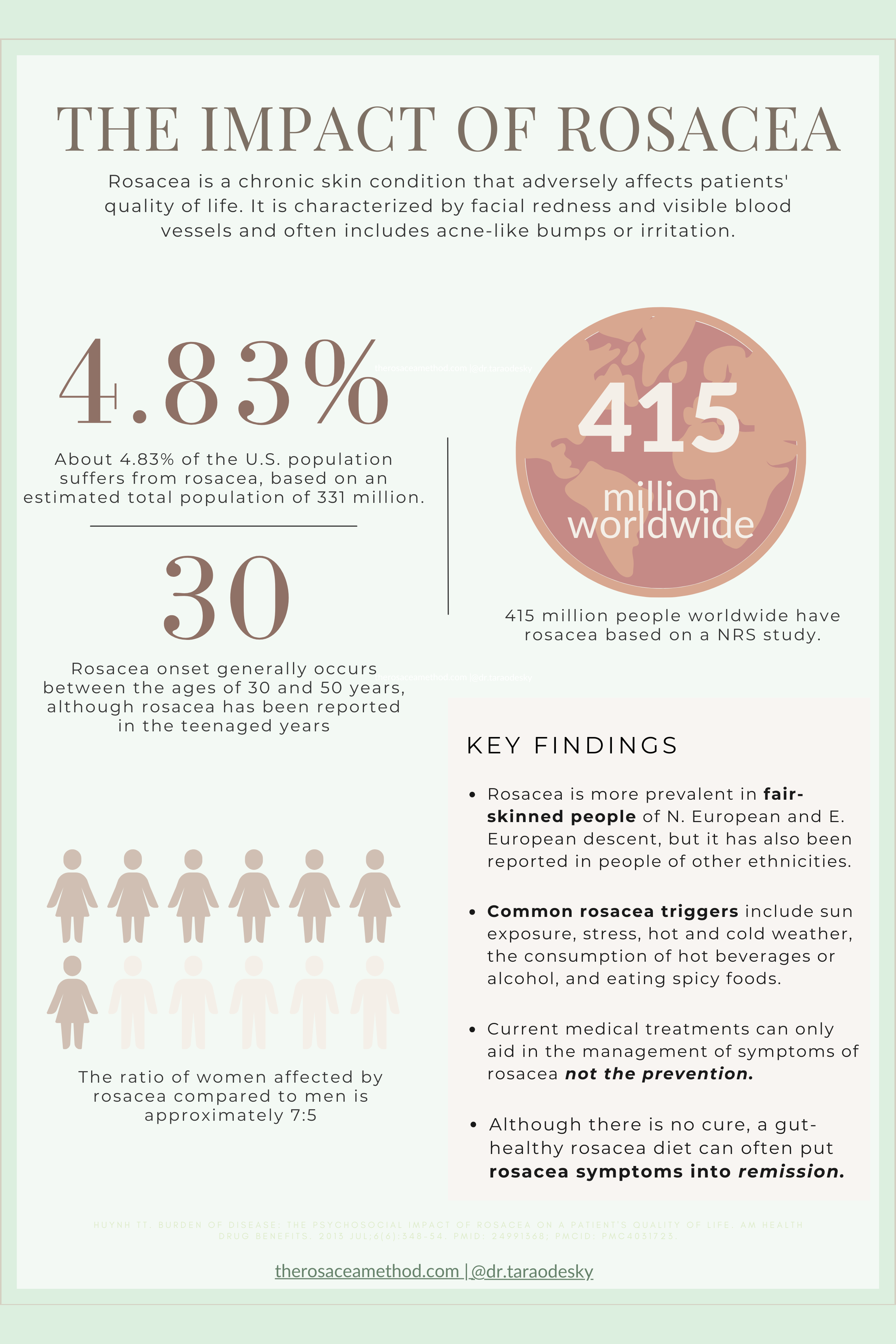
Infographic data sourced from The National Library of Medicine 3
Why are my cheeks always red? Before exploring the four types of rosacea, we must have a basic understanding of what rosacea is.
Rosacea is a chronic skin condition primarily affecting the face, head, and neck. This skin condition is much more common than most people would think; millions of people around the world suffer from and live with rosacea every day.4
The 4 most common types of rosacea can manifest on different body parts. Each type of rosacea has its own handful of symptoms that allow it to be identified by medical professionals.
What are the Four Types of Rosacea?
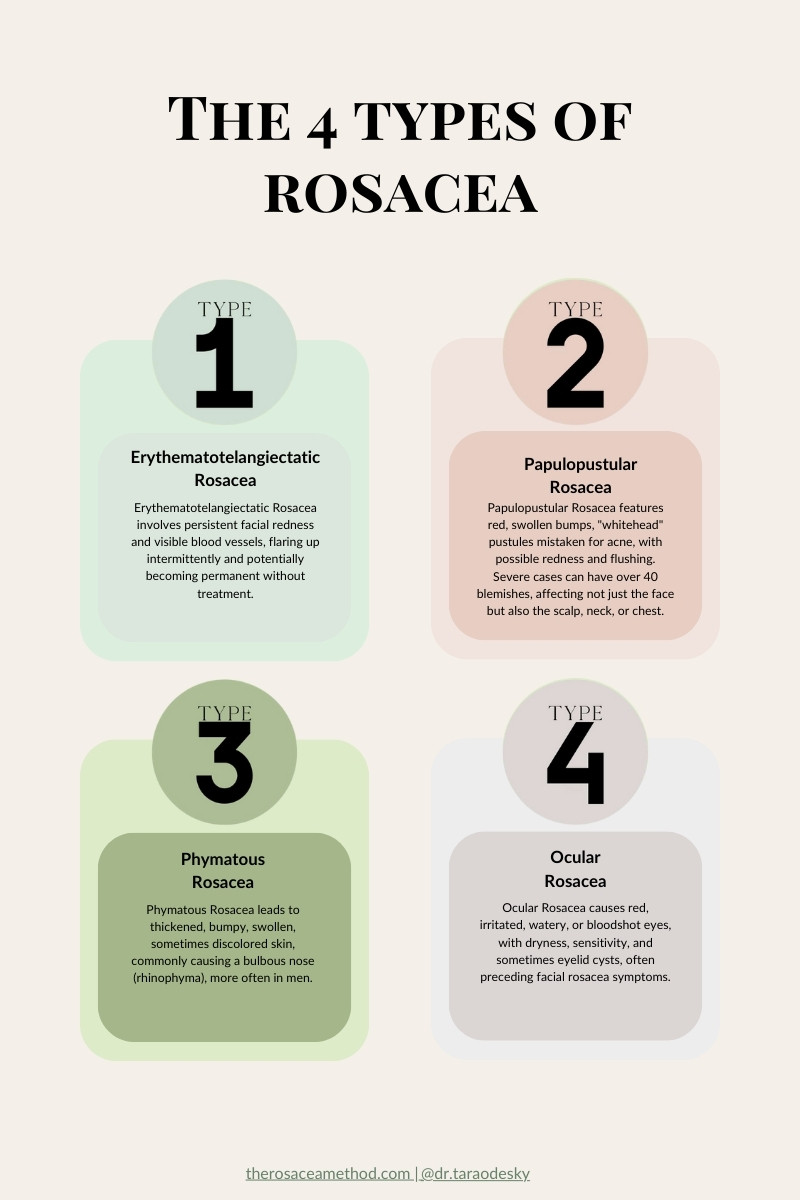
Let’s dive into the different types of rosacea. Rosacea is a common skin condition that affects millions of us. It’s important for us to differentiate these types, as it helps us accurately diagnose and find effective treatments.
We will dive into more details within this article, but just in case you are here for a quick study, let’s break down the four types of Rosacea for you:
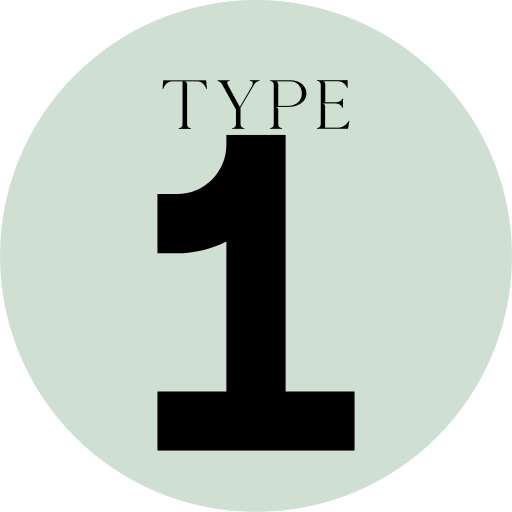 Type 1: Erythematotelangiectatic Rosacea (ETR)
Type 1: Erythematotelangiectatic Rosacea (ETR)
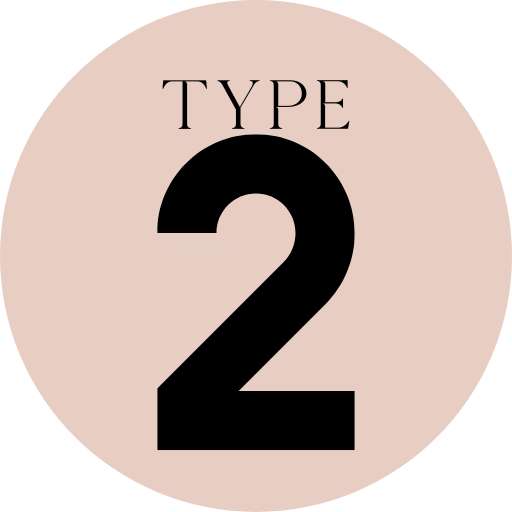 Type 2: Papulopustular Rosacea
Type 2: Papulopustular Rosacea
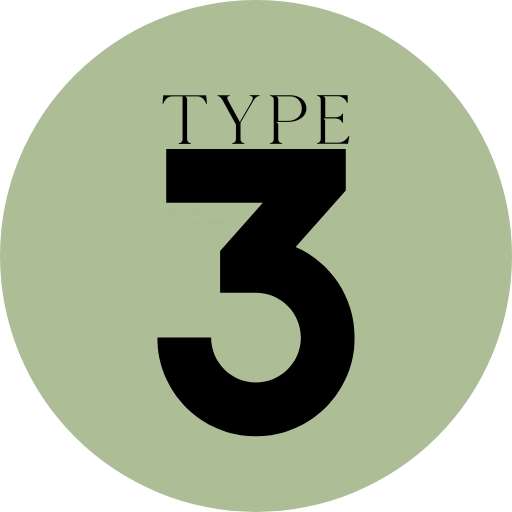 Type 3: Phymatous Rosacea
Type 3: Phymatous Rosacea
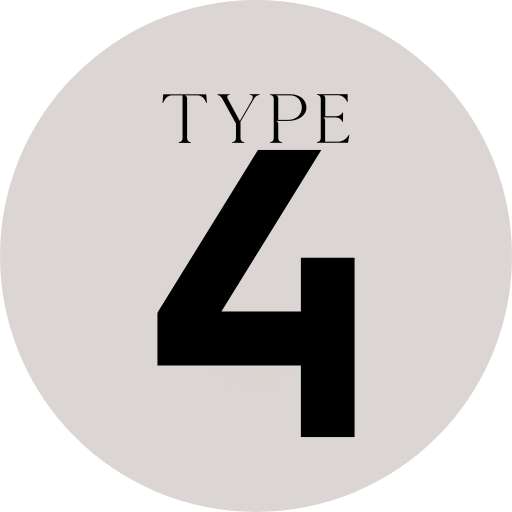 Type 4: Ocular Rosacea
Type 4: Ocular Rosacea
We’ll dissect each type’s symptoms, causes, and risks, equipping you with the vital information to confront rosacea head-on. You’re not alone; together, we’ll discover the solutions you’re looking for.
What Factors Cause Rosacea?
Understanding rosacea’s causes involves recognizing its many triggers and underlying factors. While not confined to just one type of rosacea, each form has distinct symptoms and triggers leading to flare-ups. Here are some common rosacea triggers that can exacerbate rosacea’s visible symptoms:
- sunlight
- temperature changes
- exercise
- spicy foods
- alcohol
- anxiety
- harsh skincare
- food sensitivities
Some of the visible changes you might notice when you develop rosacea are:
- skin redness
- nose inflammation
- flushing
- skin sensitivity
- facial pain
- papules and pustules
- acne-like breakouts
- itchy red eyes
- visible blood vessels on cheeks
However, these are not the sole causes. Functional medicine doctors look deeper, often helping patients to reverse rosacea by targeting imbalances and chronic inflammation by considering:
- liver
- kidneys
- mental health
- toxic exposures
- dental infection
- heavy metal toxicity
- dormant viruses
- poor gut health
and several other key factors.
The Four Rosacea Subtypes In Depth
1. ETR or Erythematotelangiectatic Rosacea
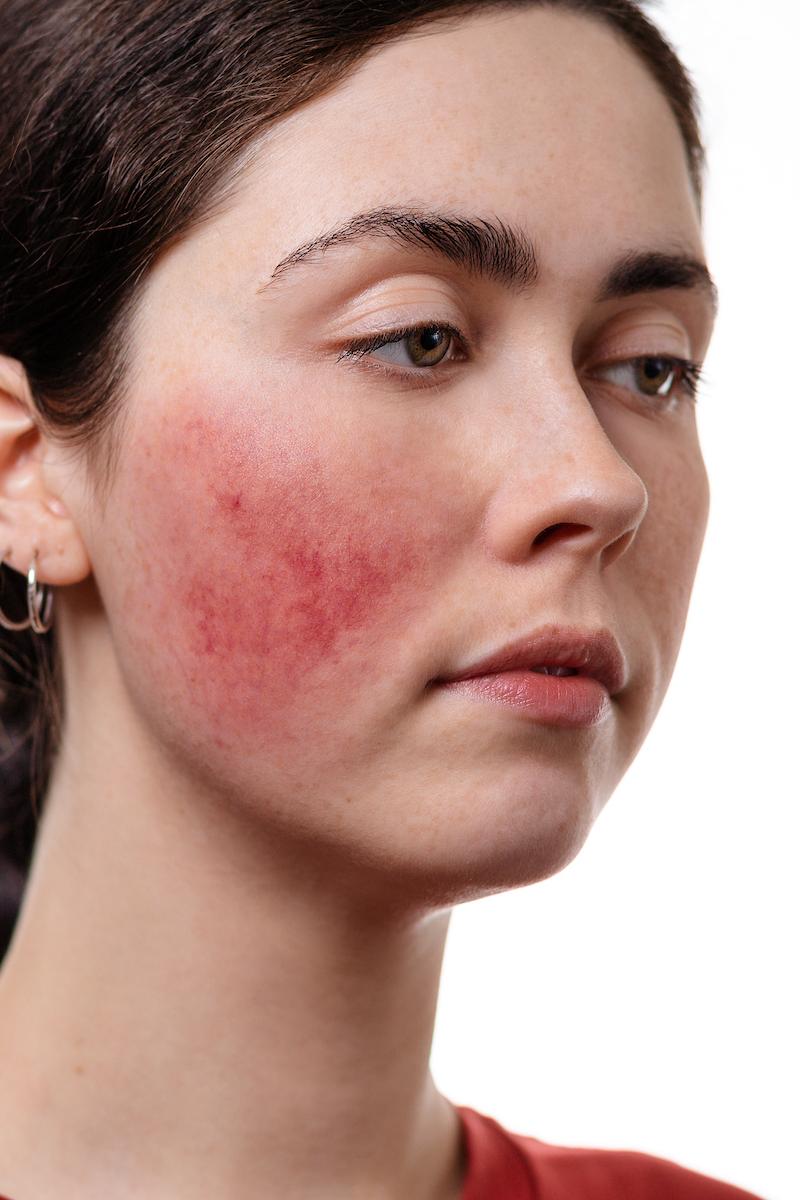
ETR Rosacea typically shows persistent central facial erythema (redness/flushing), red cheeks, and possibly the nose due to dilated skin blood vessels.5
Key Points:
- Common signs: facial redness on cheeks and/or nose
- Triggered by the skin’s blood vessels dilating
- May be chronically red or have episodes of flare-ups
Care Tips:
- Use delicate, non-chemical laundry detergents.
- Opt for gentle skin care products; less is more!
- Practice safe sun exposure to protect your delicate facial skin. Consider a sunhat to protect your face, but allow other areas of your body to enjoy the benefits of the sun!
- Avoid alcohol.
- Consider testing for food sensitivities.
2. Papulopustular Rosacea
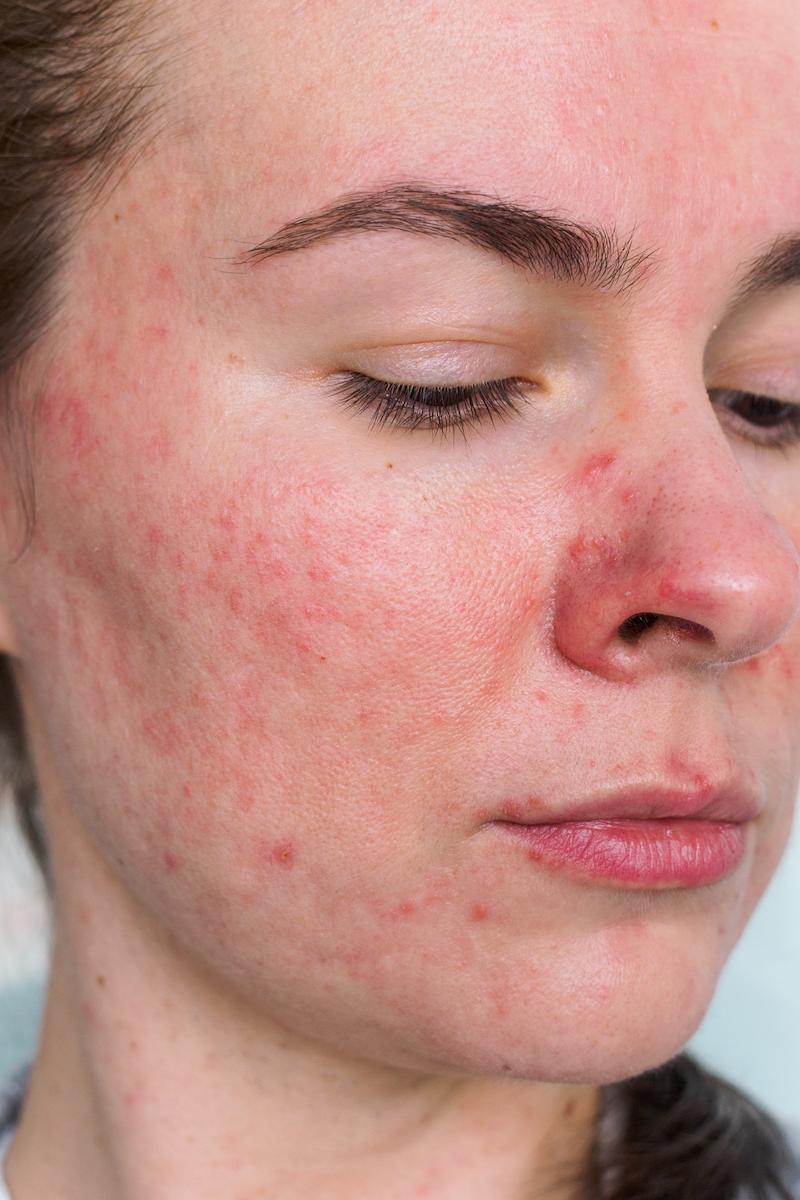
Papulopustular Rosacea (acne rosacea) often affects middle-aged women and may mimic acne, though it typically doesn’t involve black heads. Identifying this skin condition involves recognizing additional typical rosacea symptoms like spider veins, skin sensitivity, and dry skin patches.6
Key Points:
- Frequently mistaken for acne due to similar skin issues.
- Characterized by tiny whiteheads, dry patches, papules, or pustules as well as “random” breakouts, usually on the cheeks
- Often, the next stage of progression after ETR
3. Phymatous Rosacea
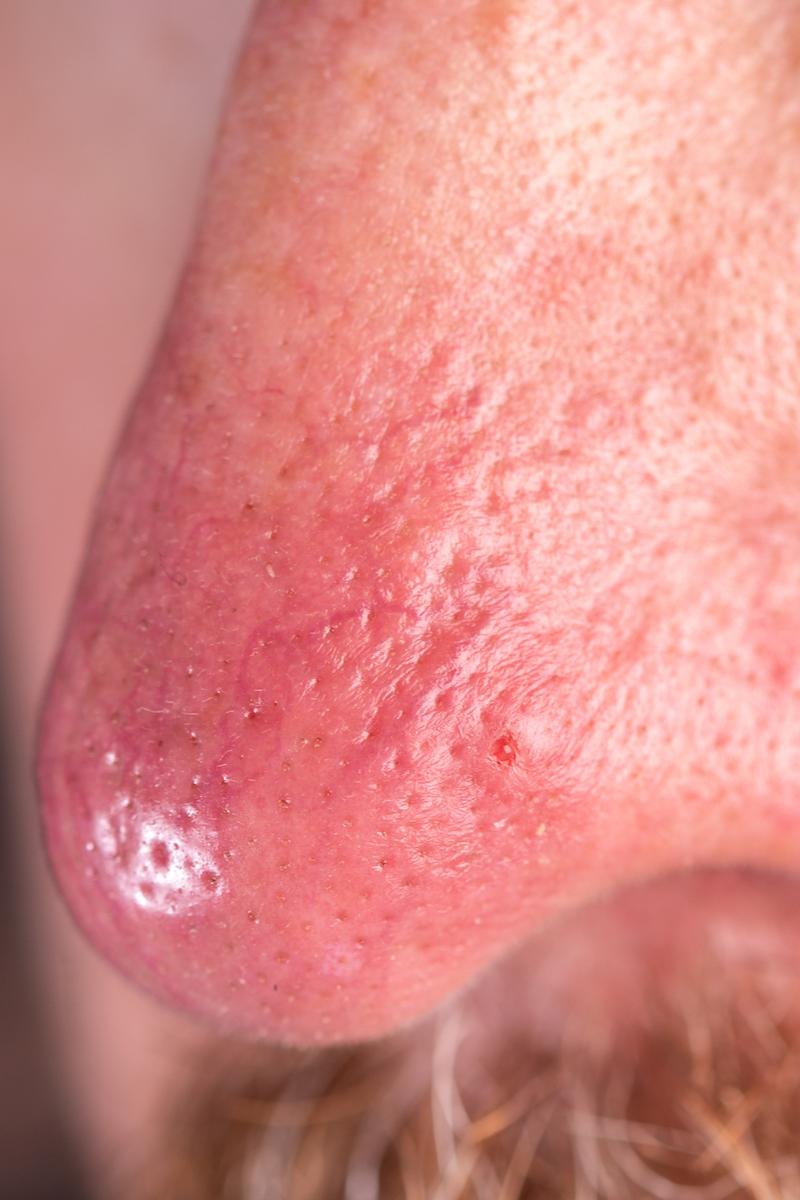
Phymatous Rosacea, more prevalent in men, often stems from untreated rosacea. Its main feature is skin thickening on the nose, leading to a bumpy, protruding nose or rhinophyma. Key signs include persistent erythema (redness) on the central face, a thickened skin texture, enlarged pores, and visible broken blood vessels.
- Severity can range from mild to severe.
- Other parts of the face may be affected by this as well
- Early diagnosis and proper treatment is crucial in preventing rosacea from developing to this level
4. Ocular Rosacea
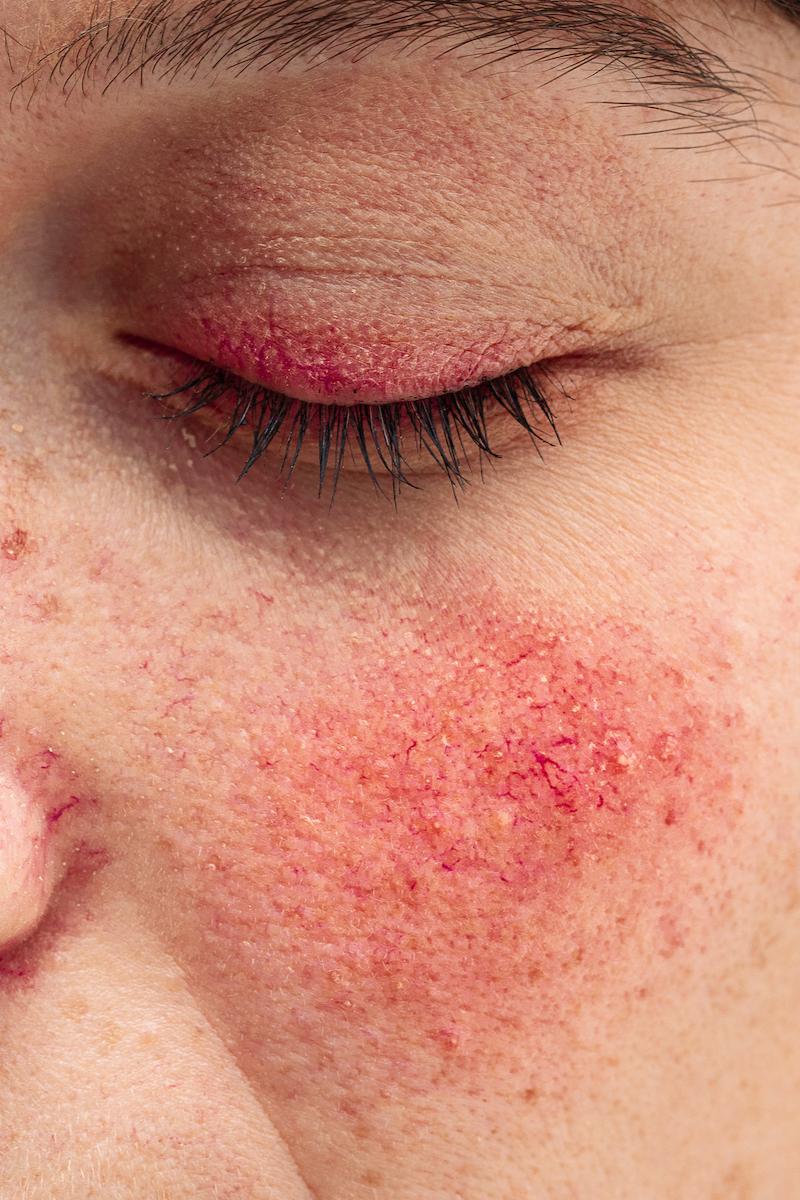
Ocular Rosacea involves the eyes and is characterized by red, itchy, dry eyes, often in conjunction with other forms of rosacea, and must be properly diagnosed by an eye doctor. Here are some considerations if you think you may be experiencing ocular rosacea:
- Watch for key symptoms: Pay attention to redness, inflammation, and tiny bumps on the eyelids, resembling small styes.
- Be aware of eye discomfort: Notice if your eyes are watery, burning, or overly sensitive.
- Eye symptoms are often most notable upon waking.
- Seek timely diagnosis and treatment: Ocular rosacea can mimic other eye conditions, making early and accurate identification crucial.
- Consult healthcare professionals: We cannot stress more about the importance of professional care to manage ocular rosacea effectively and prevent complications.
Diagnosis:
How Do I Know If I Have Rosacea?
Rosacea can present in various ways, so it’s essential to understand the different types and their symptoms. A person can often suspect they have rosacea if they:
- Observe a change in the appearance of skin and/or eyes
- Notice their skin has become more sensitive to certain materials, water, skincare, or elements like sun and wind
- Seem to blush or “turn red” more frequently and easily
- Feel a new texture to their skin, such as dry patches or a “sandpaper” feeling.
Seeking medical advice and a proper diagnosis by a dermatologist is crucial, as other conditions, like skin cancer or lupus, can have similar signs and symptoms to rosacea.
By understanding the different types of rosacea and seeking appropriate medical care, we can take control of our symptoms and improve our quality of life!
Treatment:
How Can I Control My Symptoms & Rosacea Flare-Ups?
Understanding the specific type or types of rosacea you have is crucial for effectively managing and treating this complex skin condition. There are a couple of approaches that you can take on the journey to reversing your rosacea flare-ups:
- managing surface-level symptoms with dietary and lifestyle changes
- addressing topical triggers like makeup and skincare, which often make symptoms worse
- preventing symptoms by targeting the underlying causes of rosacea naturally
Managing the Symptoms of Rosacea with your Dermatologist:
Traditional treatments like medicated creams, oral medication, and laser treatments can be somewhat effective for some individuals.
Unfortunately, these options are not meant to heal or reverse rosacea; they are meant to reduce the symptoms and must be used long-term. Traditional treatments may temporarily mask the symptoms you are experiencing but can never assess the root causes.
Therefore, they become a lifelong treatment and often don’t prevent rosacea from progressing to more advanced stages. Some traditionally prescribed treatments include:
- Laser Treatment: Laser therapy is meant to try to reduce redness like rosy cheeks, visible blood vessels, and inflammation associated with rosacea. However, many people report increased rosacea symptoms after laser therapy.
- Azelaic Acid: This topical medication can reduce inflammation and control acne-like breakouts.
- A range of oral and topical medications: Physicians may prescribe medication to manage the redness, specifically using antibiotics and other forms of medication. Initially, bumps and pimples may be treated with oral and topical medication to attempt to bring the condition under control, followed by long-term use of antibiotics or anti-inflammatory medications.
Preventing Rosacea Symptoms Naturally:
A Holistic Doctor’s Perspective
To address rosacea with a root cause approach, rosacea specialist Dr. Tara O’Desky advises educating yourself about gut health, the gut-skin axis, and the connection between liver toxicity and rosacea. Often, consulting with a functional medicine or naturopathic doctor can help you craft a personalized strategy to reverse rosacea by:
- Designing a gut-healing rosacea diet plan is the cornerstone for addressing the internal causes of rosacea.
- Pinpointing and managing your unique food allergens and sensitivities: Essential for keeping flare-ups at bay.
- Adding top-tier supplements: A vital component of addressing chronic internal inflammation
We also recommend these holistic practices:
- Stress Management: Prevent rosacea triggers by incorporating stress-reducing techniques like mindfulness, yoga, and consistent exercise.
- Detoxify Your Life: Choose chemical-free household products to prevent aggravating rosacea.
- Gentle Skincare Routine: While gentle skincare products can help maintain skin health and moisture, they alone aren’t a cure-all for rosacea.
Why the Different Types of Rosacea Article is a Reliable Source of Information and Cited Research
Exploring the various types of rosacea enriches our understanding of this skin condition, offering patients critical information about symptoms, causes, and potential treatments. Our research explores multiple scientific journals and studies, helping you make informed decisions about your skin health.
The research referenced in this article can be found cited in the Resources section below.
The Bottom Line:
Embrace Natural Solutions for Rosacea & Transform Your Skin’s Health
Armed with knowledge and understanding of rosacea, we have the power to take control of our health and improve our quality of life.
Now that you can recognize your specific type of rosacea, you can tailor your treatment plan and lifestyle choices to minimize and prevent flare-ups.
Again, It’s also important to always consult a dermatologist for a correct diagnosis, although it is never too soon to improve your gut health and rosacea diet.
And for those seeking a holistic approach to managing rosacea, Dr. Tara’s educational program, The Rosacea Method, offers a comprehensive, natural solution for rosacea.
Join the community of clear skin enthusiasts today.
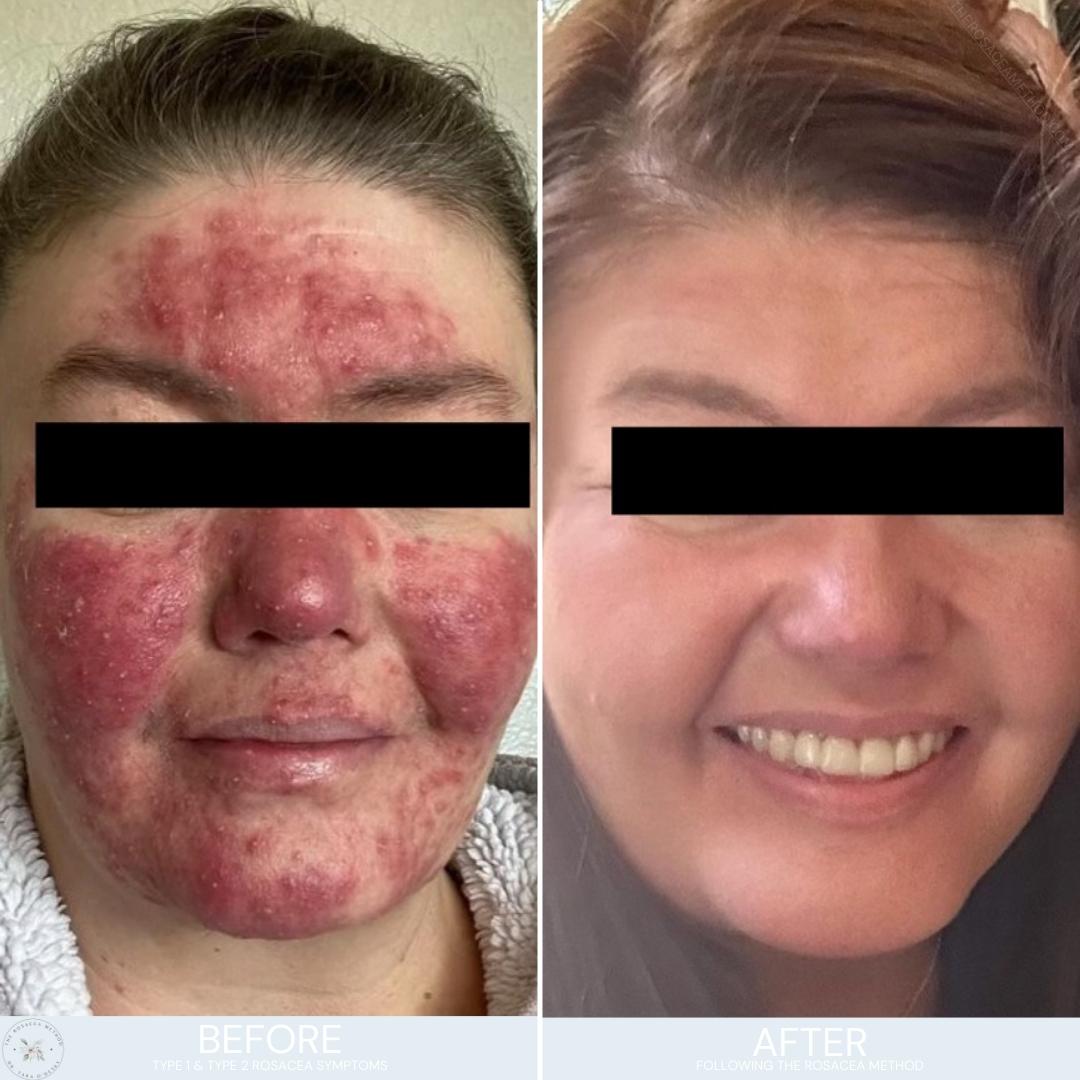
FAQs on the 4 Types of Rosacea
How do you know what type of rosacea you have?
To identify your rosacea type, consider these common signs: Erythematotelangiectatic rosacea shows persistent redness, papulopustular rosacea presents with acne-like breakouts, ocular rosacea involves eye irritation, and phymatous rosacea leads to skin thickening. Note that rosacea presentations will vary, and it’s common to have multiple types simultaneously.
What are the 4 stages of rosacea?
The four stages of rosacea are pre-rosacea with frequent flushing, often in conjunction with sensitive skin; vascular rosacea, showing visible blood vessels on the cheeks and/or nose; inflammatory rosacea with acne-like breakouts; and late-stage rosacea, leading to skin thickening. Most doctors recognize these stages as part of the common progression of rosacea.
Which form of rosacea is rarest?
Phymatous rosacea, characterized by skin thickening and papular nodularities, is the rarest and most advanced form. Protecting sensitive skin areas is crucial in managing this type.
What autoimmune disease causes rosacea?
While no autoimmune disease directly causes rosacea, immune system irregularities and sensitive skin conditions like Lupus can exhibit rosacea-like symptoms. People with rosacea often report that their rosacea developed after the onset of several other medical conditions.
References
- Kim HS. Microbiota in Rosacea. Am J Clin Dermatol. 2020 Sep;21(Suppl 1):25-35. doi: 10.1007/s40257-020-00546-8. PMID: 32914214; PMCID: PMC7584533. ↩︎
- Gether L, Overgaard LK, Egeberg A, Thyssen JP. Incidence and prevalence of rosacea: a systematic review and meta-analysis. Br J Dermatol. 2018 Aug;179(2):282-289. doi: 10.1111/bjd.16481. Epub 2018 May 31. PMID: 29478264. ↩︎
- Huynh TT. Burden of Disease: The Psychosocial Impact of Rosacea on a Patient’s Quality of Life. Am Health Drug Benefits. 2013 Jul;6(6):348-54. PMID: 24991368; PMCID: PMC4031723. ↩︎
- Fisher GW, Travers JB, Rohan CA. Rosacea pathogenesis and therapeutics: current treatments and a look at future targets. Front Med (Lausanne). 2023 Dec 13;10:1292722. doi: 10.3389/fmed.2023.1292722. PMID: 38193038; PMCID: PMC10773789. ↩︎
- Harper J, Del Rosso JQ, Ferrusi IL. Cross-Sectional Survey of the Burden of Illness of Rosacea by Erythema Severity. J Drugs Dermatol. 2018 Feb 1;17(2):150-158. PMID: 29462222. ↩︎
- Saurat JH, Halioua B, Baissac C, Cullell NP, Ben Hayoun Y, Aroman MS, Taieb C, Skayem C. Epidemiology of acne and rosacea: a worldwide global study. J Am Acad Dermatol. 2024 Jan 4:S0190-9622(24)00002-1. doi: 10.1016/j.jaad.2023.12.038. Epub ahead of print. PMID: 38184278. ↩︎
MEDICAL DISCLAIMER
This content is for informational and educational purposes only. It is not intended to provide medical advice or to take the place of such advice or treatment from a personal physician. All readers/viewers of this content are advised to consult their doctors or qualified health professionals regarding specific health questions. Neither Dr. Tara O’Desky nor the publisher of this content takes responsibility for possible health consequences of any person or persons reading or following the information in this educational content. All viewers of this content, especially those taking prescription or over-the-counter medications, should consult their physicians before beginning any nutrition, supplement or lifestyle program.
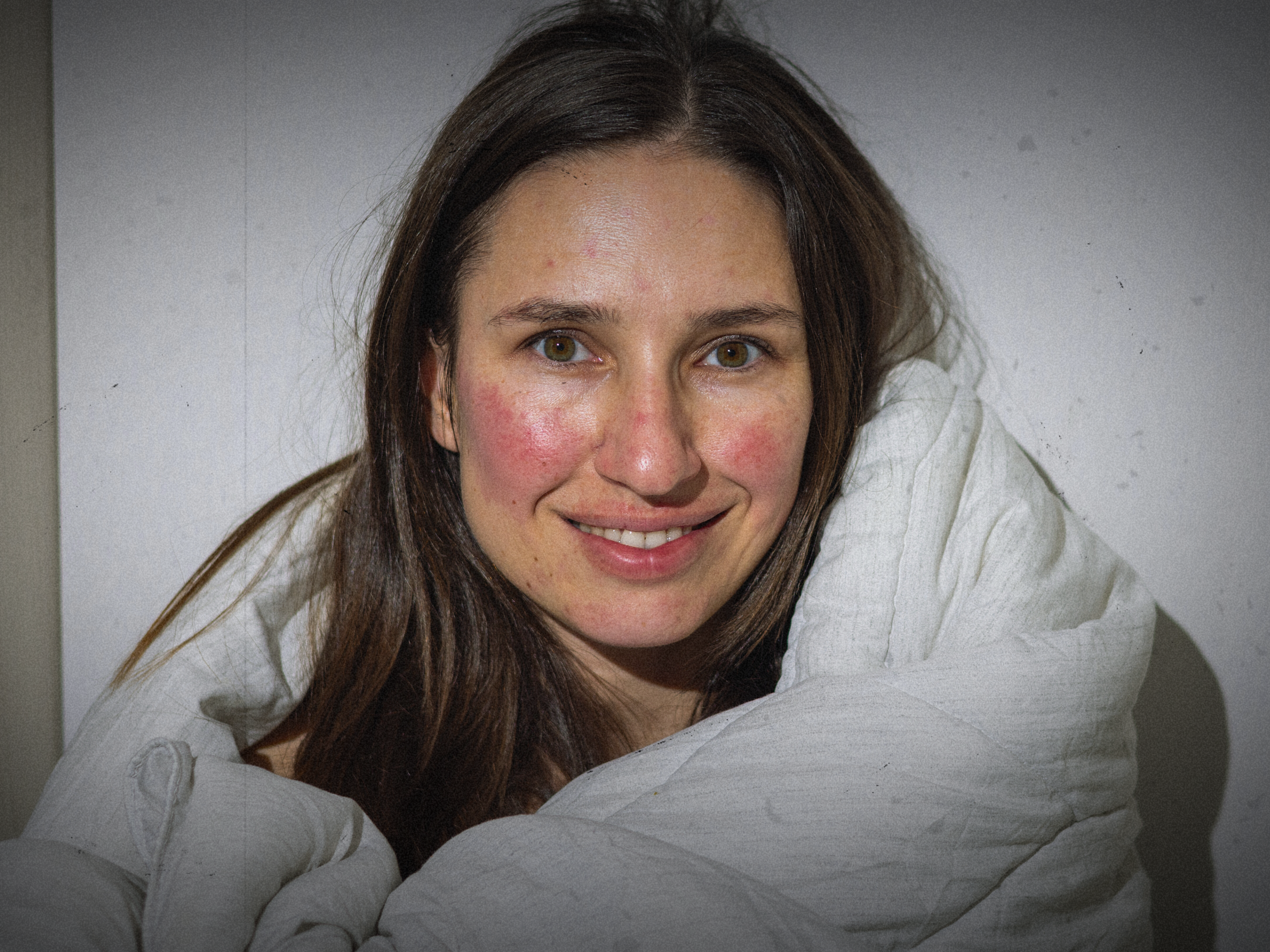
Leave a Reply
Learn More About Me
20 years of rosacea
- rosacea
- chronic skin issues
- gut issues
- food sensitivities
- inflammatory conditions
After 20 years of ineffective treatments and medications, Dr. O'Desky reversed her rosacea 100% through dietary changes and food-based medicine.
Health Coach & Holistic Skin Expert
Meet
Dr. Tara O'Desky
Since developing her own holistic healing program,
The Rosacea Method, she has helped countless patients of all ages with:
- rosacea
- chronic skin issues
- gut health
- food sensitivities
- inflammatory conditions
Dr. O'Desky continues to see patients in private practice in the USA and also sees clients via Telehealth. She currently offers various programs and workshops for people all over the world dealing with chronic health issues, poor gut health, and rosacea.
Health Coach and Holistic Skin Expert
Meet Dr. Tara O'Desky
-L. M.
"I want to say thank you so much for the program!
I never feel hungry anymore. My diet has opened up a ton and I feel really healthy and excited learning that there’s so many things I can eat now that are healthy and tasty. I felt good through the entire cleanse and my skin has definitely improved."
-Anonymous
"I felt so hopeless and I could not see light at the end of the tunnel. Now I have hope again and I feel more positive about my situation overall! Yes it can definitely heal, I have so so sure others heal! This program is great, I feel like It covers everything! Thank you! "
-Darlene B
"For the first time in 6 years, I feel like I have been given a clear direction to go in that will actually heal my skin. There's so much guess work that comes along with skin complications and Tara helps to clear all that up.Recommend 1000%."
I came across Dr. Taras website while trying to heal my teenage daughters rosacea naturally. This article is super helpful!
I hope your daughter is seeing progress! Thank you for sharing!
Can the little fuzz we have on our skin encourage the appearance of demodex?
Also, is the amount of demodex on rosacea-prone skin can it be related to our body’s internal condition?
Demodex are on all human skin, except they are more attracted to certain people (research is unsure why just yet) AND people with rosacea tend to have almost an allergic reaction to them. So they can definitely be problematic for those of us with rosacea!
I see the rarest type includes nodularities. Is that the same as grandulomas? I have grandulomas on my neck that are painful. I’ve seen my derm but they have only suggested antibiotics.
Some people in my program have these, and over time they watch them disappear! The body is always healing…!!!
Great article
Wonderful article!
Thank you for this information Dr! Can’t wait to try the rosacea method! It’s my dream!! Love from Paraguay!
Can’t wait to see you there someday!
For me the worst part are the breakouts… They leave hyperpigmentations
So sorry to hear this. I’ve met many people who did overcome this! Focus on internal healing!
I’ve had rosacea for a very long time , it was pretty controlled but I noticed as I age it’s getting worse. I’ve tried everything, don’t want to do pills. It’s sad when my small child stares at them and doesn’t understand why I have them on my face. I hope I can find healing in all this information.
I know the feeling! It CAN be healed! I thought I’d tried everything too, but there was so much more to learn and do. Good luck on your journey! And I have tons of free resources available on my website! https://therosaceamethod.com/
I have papulopustular rosacea with severe dry patches. I’m ready to heal. Thank you for all your information!
You’re so welcome!
Have had rosacea for 5 years now and I don’t know why I didn’t think to look at diet to control it until coming across your page. Thank you!
Unfortunately diet is almost never talked about in dermatology offices, and even on rosacea websites except to talk about “trigger foods.” In fact, diet can be used as medicine!
Thank you for sharing this! I have rosacea for 10 years now and it’s making me feel depressed and insecure.. but your information is very helpful! 🙌🏻
It doesn’t matter how long you’ve had rosacea… all can be healed!
Is there any correlation with blood sugar and rosacea? I’ve noticed every time I start my day with fruit alone or a pastry, my face starts to flush more. But lately I’ve been having a balance breakfast (protein+fiber+fruit) and I’ve definitely seen a lot less flushing.
Huge correlation! I have several posts on this in my IG account! @dr.taraodesky
Hi! Great article! Does the person with roscasea always or mostly will develop other stages? I have first one for a year now, just hope to stay here or reverse it all together. Or will it eventually progress?
It usually does progress, slowly. Especially with life events, changes in environment, etc. However if a person takes steps to actually reverse the underlying causes, they have a good chance of ensuring it does NOT progress.
Always so informative thank you
I haven’t even started your programme yet but I am always commenting on tik toks and Instagram pages about you, I tried to hard to find pages to help and so far yours has been the only one. I haven’t been able to afford the programme so far and I’ve followed you for a few years now but with the deal you have on at the moment I’m going to bite the bullet! I’ve managed to get my skin about 60% better with lifestyle & dietary changes over the past few years but I know I just need to take the final step and I’m confident it will fully go away! Thank you for spreading the word and helping other people!
I’m so happy this information has helped you! And thank you so much for sharing the word. You’ll never regret educating yourself about your body and how to stay healthy, for life! Welcome to the program!
Thank you so much for the info Dr! I feel like is even harder to manage it when you have 2 types of Rosacea at the same time. I have both Type 1 and 2 and I have found that products for Type 2 can be very drying on my skin (great against demodex) but horrible for my Type 1, somehow my skin just does not like them. Luckily I found your page and you made me realize that I need to heal internally first so I started following your tips from Instagram and I have seen soooo much improvement (specially the lemon water first thing in the morning). I am manifesting being able to do your program!!! I know I will someday, and I know it will make such a big change for my life and my confidence! Thank you again Dr Tara! you are really changing peoples life’s for the better!
So thankful for your resources on here 🫶🏼I’m not where I want to be yet but I continue to learn from you to help my skin and overall health
I find your resources, instagram, and blogs super helpful! I have rosacea and am learning how to navigate. My confidence has definitely taken a hit, I would love more advice and to meet with you once I have the funds.
Your information is amazing and makes so much sense. I have been battling with a combination of Phymatous and Papulopustular Rosacea symptoms. I was diagnosed as cecilac last year and since changing my diet and reducing the overload of skin care potions, my skin has much improved but I would love some guidance on how to take the next steps to repairing the remaining damage and flare ups. Thanks for the knowledge sharing.
K
It sounds like you’re definitely on the right path! And you can absolutely repair the damage and reduce flare ups moving forward!
I have blushed since a child but ever since my mid 30’s rosacea has taken hold. At first it was stage 1 but now in mid to late 40’s it’s at stage two possibly starting to progress to the eyes now I have read your blog. I have seen lots of dermatologists and am allergic to all the creams and antibiotics they prescribed. I started looking at my diet and gut a year and a half ago but still feel my rosacea is slowly getting worse. I know stress is a factor but as a teacher it is sometimes hard to relax. I love reading everything you publish but still feel I am missing something. Being at a time of life where so many changes are already taking place rosacea is is a real knock in my confidence and sadly is when I can’t afford to take part in your full programme.
One question I always have is how do you know if a flare up is because I am on the right path and healing or because I am doing something wrong that is making it worse?
Thanks for trying to help us as it’s really hard to find good advice with so many contradictions out there.
Dietary changes are helpful, but environmental factors play a huge role. Childhood exposures and chronic exposures all come into play. I hope someday you’ll be able to join the program where we can answer all your questions!
This article was super helpful and informative. I’ve always had rosy cheeks and flushing but in the last few years it has gotten progressively worse and textured. I’ve long since suspected it may have something to do with my underlying autoimmune disorder. As someone who works with children I feel the constant need to wear makeup to avoid questions and to feel “normal”. It’s definitely been demoralizing at times and I will reading into more of the dietary options that can be healing.
I completely understand how you’re feeling, and i assure you, you CAN heal!
This blog has been a lifeline for me in understanding the 4 types of Rosacea and finding effective, natural options to treat flare-ups. It’s a wealth of information that genuinely helped me navigate and improve my skin condition. Highly recommended!
This blog has proven to be an absolute lifesaver for me. The detailed breakdown of the 4 types of Rosacea and the natural treatment options provided have genuinely helped me navigate and effectively manage flare-ups. Grateful for this valuable resource!
So happy to help!
Thank you for sharing the details in the different rosacea types here. It took me so long to figure out my “pimples” actually classified as rosacea.
Do you recommend folks in your program get tested for SIBO/H. Pylori? If so, any specific tests you suggest?
Thank you for all of your work!!
A lot of SIBO and other gut issues heal on their own when you focus on gut health. We don’t suggest testing up front, but testing later if symptoms are going.
I have been learning so much reading through your blogs and posts. Thank you for helping us learn so much about our rosacea.
I’m so glad you’re finding the info helpful!
I have Ocular Rosacea, I’m just now learning about it and am going through this laser treatment. I have so much to learn still. Ive been dealing with this for 2 years with my eyes and I can’t take it anymore. Do you have pictures of people with this.
Many of the people in our program have both facial and ocular rosacea. And many have healed! I wish I had taken photos of my own eyes when I had it. But you can read in the testimonials section from several people who’ve healed their OR as well.
Such useful information for those of us suffering with any form of rosacea. It’s such a frustration when you’re “doing everything right,” but still have flare ups. But as Dr. Tara points out, there are complex reasons that lead to flare ups, and being frustrated does not help the skin. Thanks for always giving us hope, useful tips and guidance.
I understand the frustration, and you’ll get there, i promise!
This was so helpful in understanding the 4 types and being able to pin point mine. Looking forward to learning more and how to heal my rosacea #2.
I have just been diagnosed with granulomatous rosacea. Is this an entirely different category?
This is a very rare form and is considered a variant of rosacea, not a type of rosacea.
The information in this post is incredibly helpful. My dermatologist diagnosed me with rosacea several years ago, but basically said there’s nothing she can do about it. There was no discussion of kinds or stages, and laser was the only “treatment” offered. The laser did nothing to improve the redness. Thank you so much for this information. Truly helpful in my quest to treat my rosacea.
You’re so very welcome! Keep reading… there’s so much to learn!
My dermatologist says that some red marks on the skin are scars from the rosacea and only threatening with laser could possibly help? I wonder if that is true, can all red vains like scars can heal do you think? It confuses me a lot…
I’m still uncertain of which type I have, however is there also a genetic factor? My mom has it, I have it and I see it developing on my 21 year old brother.
There is definitely a genetic factor! The sooner you start the process of reversal, the better!
Thank you for share this incredibly helpful information!
Love learning ways to treat it naturally!
Happy to help!
Great Information.
Thank you!
Inspiring Transformation
Yes!!!
This blog is very interesting and helpful
I’m glad I found you.